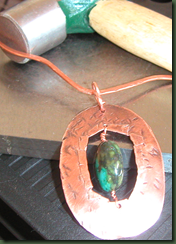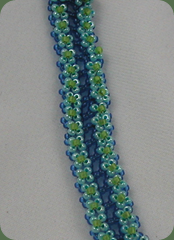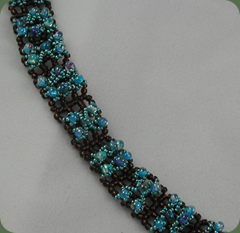The title for today’s entry is not originally mine. It comes from a chapter in The Mindful Woman by Thoele. She discusses how healthy children demonstrate excitement and take the time to be truly present in each new experience. As adults, it seems the beginner’s mind leaves us in the midst of multitasking, tedium, and repetitive living. I wonder if we could change that?
While many of us find our beginner’s mind with brand new experiences, I was reminded yesterday of the awakening when adding a new dimension to a previously learned task. My friend was here (thanks Szarka) and helped me practice making better wrapped wire loops for my jewelry. If you are a wire worker, you’re probably laughing and wondering how this simple task could help garner beginner’s mind. Let me explain. My wire loops have been terrible for years. Since I didn’t know any better, I wasn’t concerned until my friend began inspecting things (in a kind way of course). Then I realized there must be more than crooked misshaped loops and scratchy ends. Rather than feeling like a failure after my friend helped me, I tackled those loops with enthusiasm. As long as I looked for improvement rather than mistakes, my beginner’s mind was active and I was enthusiastic. I can’t say that the picture herein shows perfect loops, but it does show improved loops. Luckily, I need to make many more loops to complete this necklace; so I’ll get plenty of practice. While I used to think that I had to learn a completely new skill to engage my beginner’s mind, thankfully, I now realize that  isn’t always necessary.
isn’t always necessary.
Drawing upon what I know about brain development, each person’s understanding of how to awaken their own beginner’s mind may be more important than we realize. Many researchers tell us that the dendrites in the brain which can branch to form new neural connections branch solely when we are involved with new, active, challenging learning in a risk free environment. Doesn’t that occur when we move forward from experiences in our beginner’s mind. In my case, beginning and branching dendrites also seems to bring joy.
Consider the difference in those who are elderly. Some are still pleased with life and interested in reading, working puzzles, playing games, etc. Others, however, are no longer engaged with life. Some of this variance results from health and/or emotional issues, but much of it is a matter of stimulation and brain engagement. My Mother, for example, once despondent, confused, and uninterested in life, is now a bridge-playing, piano player who reads constantly and is ready to get a move on at 88 years of age. The difference came as she left a solitary home life, moved to a nursing home and became stimulated and challenged along with others her age.
We are told that our dendrites can continue to branch into our 80s and 90s. Hooray! There’s still time to make those connections. I believe I’ll continue to seek activities that engage my beginner’s mind and hope for the best!









